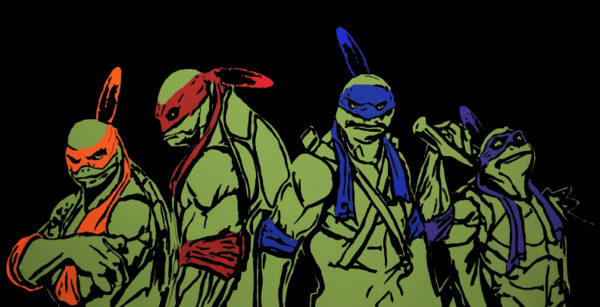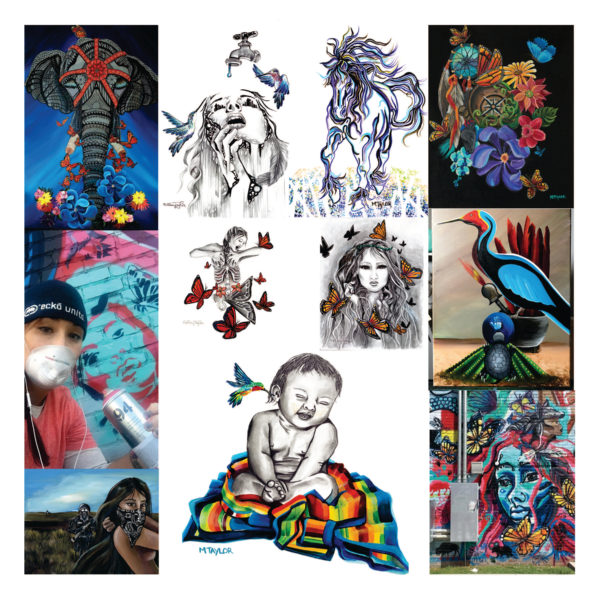The organizers behind Native Pop hunted for “hardcore, cutting-edge” indigenous artists to form their collective. The idea was to educate the public that Native people do more than traditional arts and crafts; they also make progressive art that’s intelligent and provocative. The unified voices also strengthen the dialogue that Native people are still here. “We’re still relevant,” says Brent Learned, Cheyenne/Arapaho, the award-winning artist and leading organizer of Native Pop. “We want our voices to be heard.”
Native Pop is a traveling showcase of today’s most progressive Indian pop artists representing a diverse spectrum of tribal heritages. “It’s kind of a living organism,” Learned said. “We adapt it to different types of events.”
After its debut, month-long exhibit at The Paseo Plunge in Oklahoma City in July 2016, Native Pop was asked to show at Pop Gallery in Santa Fe in August 2016, followed by California’s American Indian and Indigenous Film Festival in Palm Springs in November 2016. It’s currently on display at Red Cloud Indian School in Pine Ridge, South Dakota. In March, four Native Pop artists will represent the Native pop art movement at the National Reservation Economic Summit in Las Vegas. In October, the exhibit will head to the Bishop Gallery in Brooklyn.
Download Today! 50 Must-See Modern Native Films and Performances
Enjoy films for and about real Indians Natives when you download our special free report, 50 Must-See Modern Native Films and Performances!
Download Today!It’s gained popularity across social media like a “tidal wave,” Learned said. Since Native Pop formed, the artists have heard from new fans and industry worldwide from Germany to Australia. “The people, they want more of it,” he said.

Steven Paul Judd
More than two years ago, Learned tapped Muscogee Creek and Seminole multi-media artist Joe Hopkins to help him bring Native Pop to life. The pair compared lists of the best pop artists in Native circles, starting with the most prominent names in the pop art world in Indian country, like Bunky Echo-Hawk (Yakama/Pawnee), designer for the Nike N7 line, and Steven Paul Judd (Kiowa/Choctaw), a celebrated filmmaker and artist.
Several other esteemed artists form the core of Native Pop, along with Learned, Hopkins, Echo-Hawk and Judd, including George Curtis Levi (Southern Cheyenne); Joshua Garrett (Seminole/Creek/Kiowa); J. NiCole Hatfield (Comanche/Kiowa); Oneka M. Jones (Temock Tribe of Western Shoshone/Northern Paiute); and Mallory Taylor, (Osage, Cherokee, Blackfoot, Crow, Black Dutch and Irish descent).
It took nearly two years to gather a collective of artists from different tribal nations to showcase works that reflect their backgrounds and pop culture. “Each artist brings a unique style to the table,” Learned said. “They’re very sought-after artists, and not only that, their craft is well defined. I think they carry a good voice for the younger generations coming up, but also echo the ones that come before them.”
Through the lens of pop art, they offer fresh perspectives on Native history and modern indigenous identity, as well as critical social justice issues. They demonstrate the power of art as activism and documentation — such as through the NoDAPL movement and its empowering motto “Water Is Life.”
“We’re all affected by that. As artists, we reflect society. We are historians of our time,” said Learned, a painter and sculptor from Oklahoma City.
Art can be described as a musing of societal change. The Native Pop exhibit reveals how Native Americans also adapt with the times and reflect the ever-shifting cultural landscape through art in its myriad forms. “Art always evolves. It’s like society itself, it’s always moving,” Learned said.
Beyond tribal affiliations, the common thread between the various Native Pop artists is pop art. Learned and Hopkins are quick to point out the distinction between pop and contemporary art. The two genres can get “cluttered,” Hopkins said. “It’s a fine line.” Pop art employs popular or iconic imagery, whereas contemporary art is less well-defined and generally ascribed to works by artists living today, art related to modern-day themes, or art created through new mediums.
Native pop art is yet another animal. It’s re-appropriating and reclaiming indigenous imagery that has been exploited by mainstream society, and depicting it through a Native artist’s eyes. “It’s literally a whole new archetype of movement,” Learned says.
Download Today! 50 Must-See Modern Native Films and Performances
Enjoy films for and about real Indians Natives when you download our special free report, 50 Must-See Modern Native Films and Performances!
Download Today!Native Pop is also trying to shake antiquated stereotypes attached to indigenous art. It’s too often equated with Southwestern art at large, or perceived through a narrow lens: Pueblo pottery, sepia-tinted paintings, turquoise jewelry, etc. “We’re trying to lead that movement: Not all Native American art is Southwest art,” Hopkins said.

Hopkins’ spin on the Teenage Mutant Ninja Turtles (TMNT), as “TMNDNT”.
For instance, Hopkins liberates Native art of its “sad representation” and earth-toned, landscape-driven identity with vibrant splashes of color and pop icons, like the Teenage Mutant Ninja Turtles. The animated characters symbolize the relationship between Native Americans and the rest of society. “Ninja Turtles are in the shadows,” Hopkins said. “As Native Americans, we’re here, but we’re not seen.”
Native Pop’s cast of artists continues to grow. Here are some of the innovators who help to define it:
Bunky Echo-Hawk

bunkyechohawk.com/bunkhaus-blog
“I call this painting ‘Simple Math’ because to me, it should be an obvious understanding that water is greater than oil. You can’t drink oil. You can’t even drill for oil without water. Water is life,” Echo-Hawk writes on his blog, Bunkhaus.
“It is my goal to truly exemplify the current state of Native America through art,” says Bunky Echo-Hawk, a traditional singer and dancer of the Pawnee Nation and an enrolled member of the Yakama Nation. Echo-Hawk is a multi-talented artist whose work spans both media and lifestyle. A graduate of the Institute of American Indian Arts, he is a fine artist, graphic designer, photographer, writer and a non-profit professional.
Steven Paul Judd

Courtesy Joe Hopkins
Steven Paul Judd is an Instagram sensation @stevenpauljudd
Steven Paul Judd, Kiowa, is a director best known for his Native films, American Indian Graffiti: This Thing Life, and Search for the World’s Best Indian Tacoand Ronnie BoDean. He recently published the novel The Last Pow-Wow with That Native Thomas. The multi-media artist makes “instillations” rather than “installations” — “We gonna instill knowledge to non-Natives and some cultural pride in the Natives,” he previously told ICMN.
Mallory Taylor

Courtesy Joe Hopkins
Mallory Taylor hopes her work resonates with all Nations, and particularly women.
Mallory Taylor tells a story of cultural identity through art. “Pop art is a contemporary style that allows a unique way for me to paint a story. My art emphasizes how historical and current events have impacted my life as a mixed race woman in the 21st Century that I hope not only Native Americans enjoy but all nationalities, especially women,” says Mallory Taylor, a self-taught artist of Osage, Cherokee, Blackfoot, Crow, Black Dutch and Irish descent.
Brent Learned

Courtesy Joe Hopkins
Brent Learned portrays Indians in a rustic yet vibrant, impressionistic style.
“Native American artwork is always evolving. As we change, so do our cultures and so does our art. This show is a reflection on all of that,” says Brent Learned, Cheyenne/Arapaho, an award-winning and collected artist who was born and raised in Oklahoma City.
J. NiCole Hatfield

Courtesy Joe Hopkins
J. NiCole Hatfield finds inspiration in old photographs of American Indian men and women.
Native Pop art to me is “a breath of fresh air, color, and a little piece of my mind,” says J. NiCole Hatfield, Comanche and Kiowa. J. NiCole Hatfield, a self-taught artist who refers to painting as “her voice,” uses her preferred medium of acrylic to translate her bold colors to canvas.
Oneka M. Jones

Courtesy Joe Hopkins
Oneka M. Jones, an enrolled citizen of the Temock Tribe of Western Shoshone, and a descendant of the Northern Paiute, grew up on the Duck Valley Indian Reservation of the Western Shoshone and Northern Paiute peoples, on the Northern Nevada/Southern Idaho border.
“I don’t think there is a more expressive way to paint in this day and age, than with Native Americna pop art. To be able to put a Native American spin on anything that’s popular right now; whether it’s an icon, brand, or to make a statement on a situation in the world. Native American pop art is a way I can remind the world that we, Native Americans, are still here. Native Americans were and still [are] the original American icon, even before it was America,” she says. Jones has always had a passion for Western Shoshone art, ranging from her own jewelry-making to fashion design.
Joshua Garrett

Courtesy Joe Hopkins
“Native Pop is about obtaining control over who you are and the gifts you possess and executing those forces with extreme love and benevolence,” says Joshua Garrett, a self-taught artist.
“For me, Native Pop has been about embracing the historical and spiritual aspects of my heritage. Native Pop has allowed me to focus a little more about who I am and where I come from as a Native American living in the United States,” Garrett says.
Joshua Garrett is currently featured at The Paseo Plunge until February 26 in an exhibit titled “Catching Shadows: Interpreting the Works of Edward S. Curtis.”
“My work is based on my experiences regarding conflicted spirituality, cultural isolation, over consumption and being deaf,” he said in a statement for The Paseo Plunge.
Download Today! 50 Must-See Modern Native Films and Performances
Enjoy films for and about real Indians Natives when you download our special free report, 50 Must-See Modern Native Films and Performances!
Download Today!George Curtis Levi

“My work is about my people, it’s about who I am, where I come from. It’s about a history that still lives on,” Levi says.
The art and history of the Cheyenne people, as well as his family, inspire and motivate George Curtis Levi, a member of the Southern Cheyenne Tribe, who is also of Arapaho and Sioux descent. His portfolio includes pop art, ledger art, watercolor paintings, partfleche/rawhide work and custom beadwork. He has shown his art in all the major Indian art markets and has had several solo shows across the U.S.
Joe Hopkins

Native Pop is “the expansion of exploring other mediums of expression and creativity while keeping within the traditional subject mater. … We are limitless (as) to what we can create,” Hopkins says.
Hopkins, an enrolled member of the Muscogee (Creek) Tribe of Oklahoma, is a self-taught artist with a degree in visual communications. He blends pop art style with vivid colors creating raw and powerful images. Among Hopkins’ favorite creations is his take on “White Man’s Moccasins” of an old man sporting Converse sneakers. He’s sitting on a boom box in Hopkin’s version, “probably listening to pow wow jams,” he said with a laugh. He’s also proud of The Heart of a Warrior, painted in three powerful colors: red, black and white. Check out more of Joe Hopkins’ artwork on his company’s website, sockmonkeyonline.com, as well as Facebook and Instagram.





